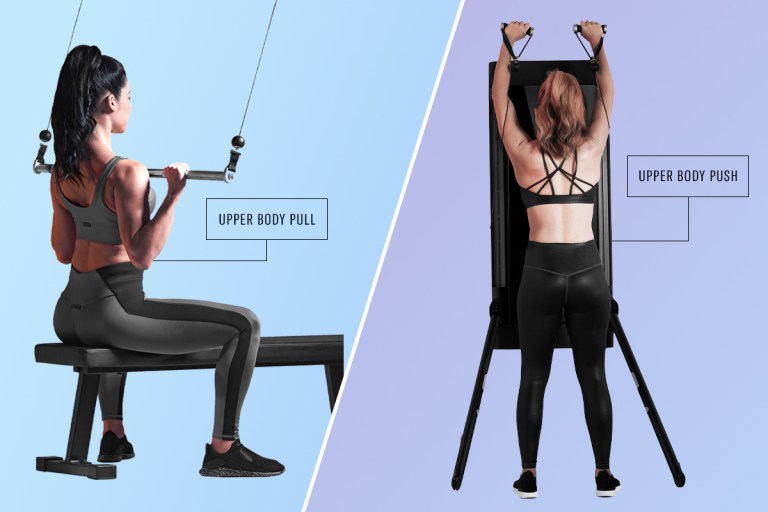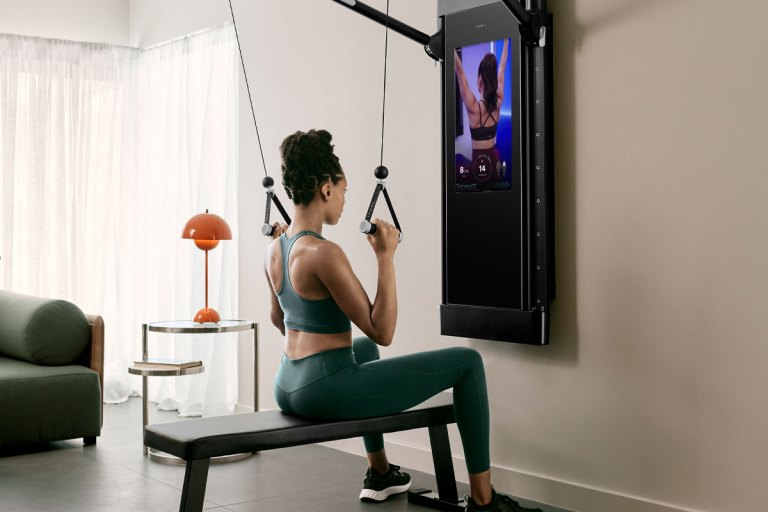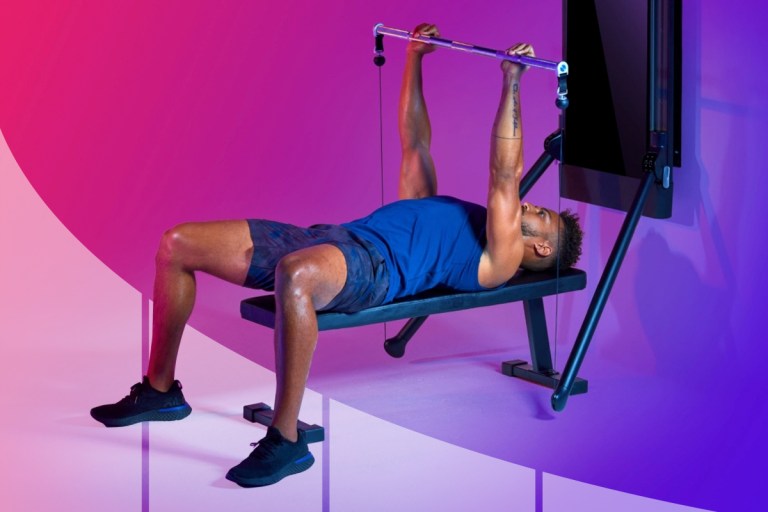Build Muscle and Maximize Recovery Time with This At-Home Push Workout
Strengthen your chest, shoulders, triceps, and quads without traveling to a gym.
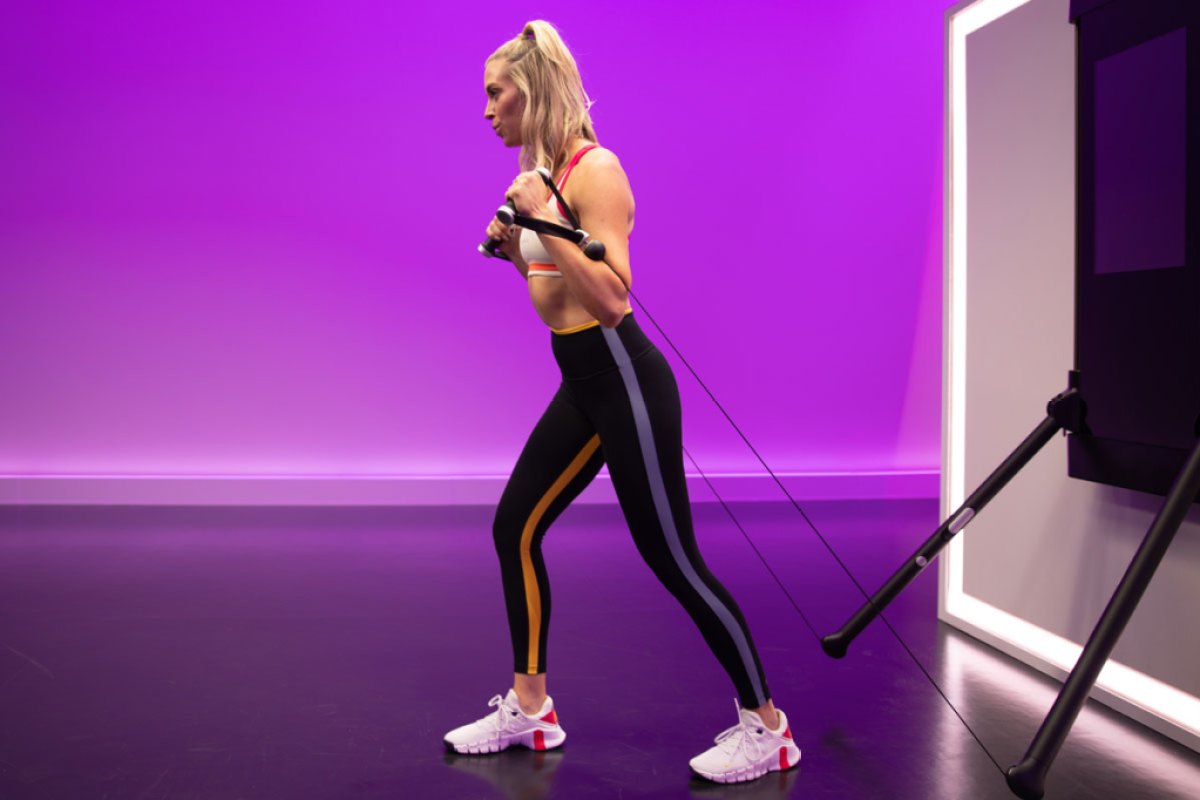
To train efficiently, you need to challenge all your major muscle groups without risking injury by skimping on recovery or overtraining a specific area. Push-pull training, in which you break up your workouts by grouping muscles that perform similar actions—pushing or pulling—is a tried-and-true strategy for balancing your workouts.
When paired with a pulling session, an at-home push workout builds your pushing muscles such as chest, shoulders, and triceps while allowing ample time for recovery. All your push muscles will get a chance to rest on pulling days, and vice versa. “You’re not working the same muscle groups in the next workout, so you don’t feel like you’re overdoing specific movements,” says Tonal coach and certified personal trainer Ash Wilking.
No matter how much lifting experience you have, you can use push-pull training to hit your goals. Beginner lifters can start with one push day and one pull day each week, while those who are more advanced can do two push days and two pull days.
Here are Wilking’s guidelines for creating an at-home push workout that’ll help you reach your goals.
What Are Push Exercises?
“A push workout is where we focus on targeting muscles that create a pushing motion,” says Wilking. “These muscles tend to fall on the front, or anterior, side of the body.” Pushing muscle groups include the triceps, chest, shoulders, and quads. In contrast, the primary muscle groups used for pulling are the back, biceps, and hamstrings.
If an exercise’s name includes “push” or “press,” that’s a pretty good indication that it’s a push move. Typical push exercises include pushups, bench presses, chest flys, and overhead presses for the upper body, and squats and lunges for the lower body. These exercises translate to pushing motions in everyday life such as lifting a heavy object overhead or pushing yourself up from sitting on the ground.
An at-home push workout will include a variety of push exercises for different muscle groups, using external resistance or just your body weight.
What Is a Good Push Workout Routine?
When you’re designing an at-home push workout routine, you’ll want to include exercises that target the major pushing muscles of both the upper and lower body. Wilking says she’ll typically start a push workout with big lifts for larger muscle groups (for example, the chest) and finish with isolation exercises for smaller muscles like the triceps. Here are the moves she recommends for a solid at-home push workout.
Depending on the time and equipment you have available, you can do roughly 4 to 8 different exercises on a push day. Make sure you include moves that work all your different pushing muscles, especially if this is the only day you’ll be working these muscles each week. If you have time for additional moves, add in ones that target the same muscles from different angles. For example, a basic routine may include just a bench press for your chest but a slightly longer workout could add in a standing chest fly variation.
The number of reps and sets you do for each exercise will depend on your goals. Go for lower rep sets with higher resistance if you’re going for strength gains, and higher rep sets with lighter weights for improvements in work capacity and endurance.
Bench Press
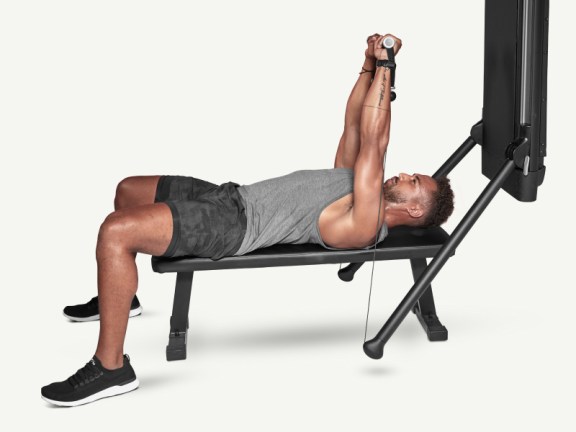
Why it Works: The classic bench press is a longtime favorite for building a stronger chest. The move also gets your shoulders and triceps in on the action.
How to Do it: Lie on your back with your head near Tonal. Plant your feet on the floor, chest in line with the end of Tonal’s arms. Grab the handles and bring your arms straight over your chest. Lower down by bending the elbows about 45 degrees from the body with forearms perpendicular to the floor. Press your knuckles straight up to the ceiling to finish with your hands above your chest.
Standing Overhead Press
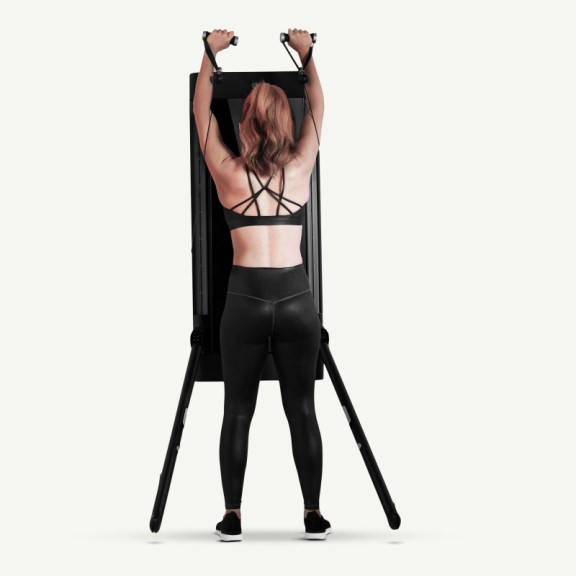
Why it Works: When planning your at-home push workout routine, Wilking recommends including moves that follow different movement patterns. While the bench press is a horizontal push, the overhead press is a vertical push so it works your chest and shoulders from different angles. Because it’s performed standing, this overhead press variation requires core stability to maintain an upright posture.
How to Do it: Press both arms up overhead reaching the knuckles toward the ceiling, but keeping the shoulders pulled toward the floor. Bend the elbows to slowly bring the hands back to start.
Standing Incline Press
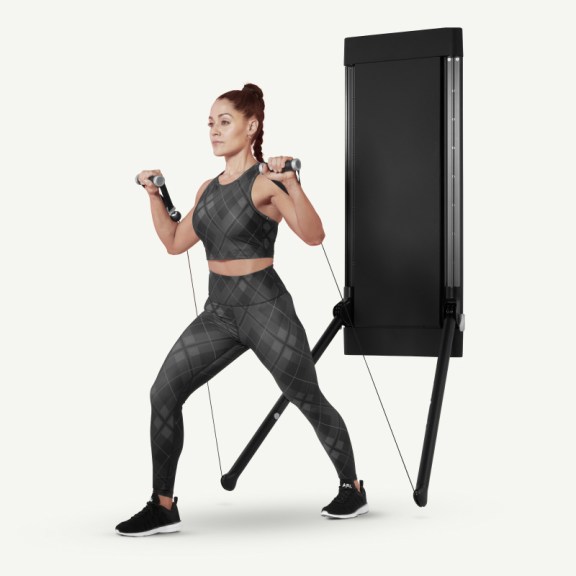
Why it Works: “Different angles work different structures of the muscle,” says Wilking. Along with straight horizontal and vertical pushing, lifting at various angles in between ensures you’re hitting all areas of the muscles. The standing incline press is especially effective at working the upper pecs. (Learn about vertical pull exercises here.)
How to Do it: Press your hands forward and up in front of your forehead using your chest and shoulders. Imagine a barbell lying against your back, from the heel to the top of your head, keeping your body in a straight line. Bend your elbows to bring your hands back to your chest.
Decline Chest Fly
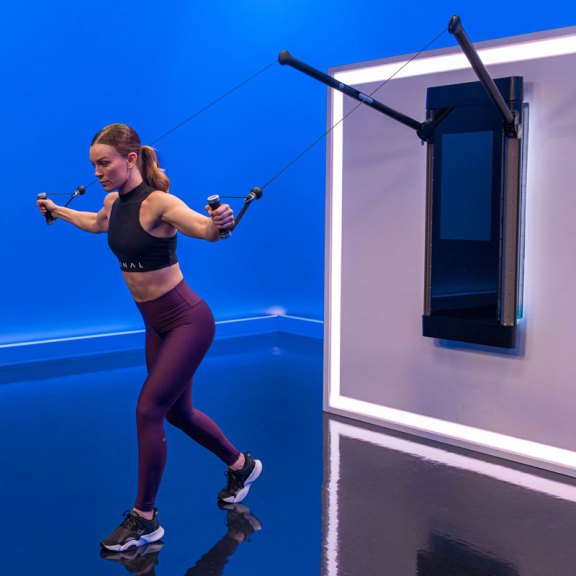
Why it Works: Balance out the standing incline press with this chest exercise that targets the lower pecs, as well as the shoulders and triceps.
How to Do it: Take a handle in each hand and extend the arms in front of you slightly below your chest like you’re hugging a beach ball. Open your arms back and up toward Tonal, keeping them slightly bent, until they are almost in line with your shoulders. Bring your arms back to center and slightly below the chest, and repeat.
Lateral Raise
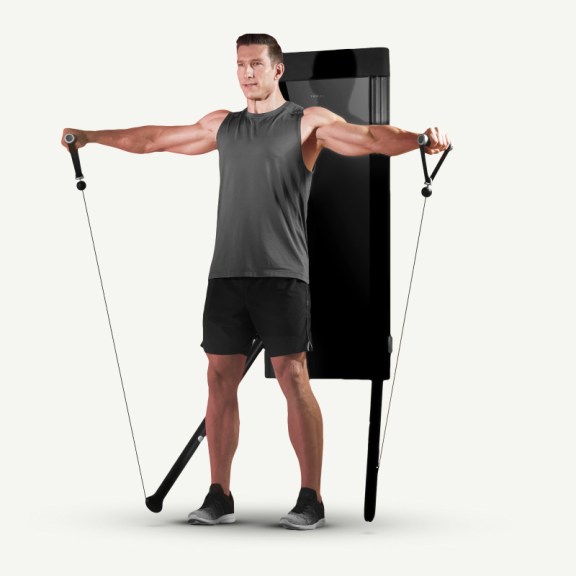
Why it Works: Isolate the deltoids, the main muscles of your shoulders, with this move.
How to Do it: Take a handle in each hand and stand facing away from Tonal. With soft elbows, lift your arms up to your sides toward the ceiling until they reach shoulder height. Lower the arms with control and repeat.
Triceps Extension
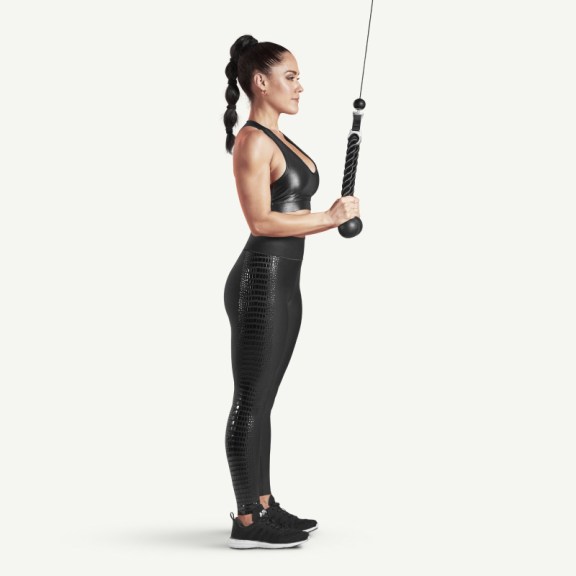
Why it Works: After working on the “big, prime movers,” in this case your chest muscles, Wilking likes to wrap up an upper-body push workout with a burnout set focused on the triceps. By working your triceps in this accessory exercise, you’ll build up the muscles that’ll ultimately help you go heavier in primary lifts such as the bench and overhead press.
How to Do it: Extend your elbows to bring your hands down toward your hips, working the back of the arms. Imagine a magnet between your shoulder blades as you pull the rope down. Control your hands back up until they are just above the elbows.
Goblet Squat
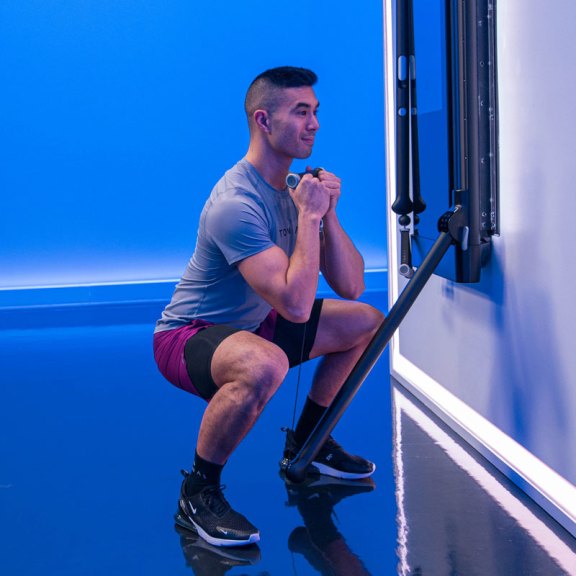
Why it Works: The lower-body component of an at-home push workout should center on your quads, the main pushing muscles in your legs. You can mix in unilateral squat variations (such as the goblet split squat or Bulgarian split squat) for balance and stability, but you’ll definitely want to include a basic squat in which you can load up the resistance and go for strength gains.
How to Do it: Hold the handle strap with your thumbs wrapped around the top and position it in front of your chest. Stand with feet shoulder-width apart and toes slightly turned out. Reach your hips down and back like you’re sitting into a chair behind you. Push the floor away from you and stand tall powering the hips toward Tonal and repeat.
Goblet Reverse Lunge
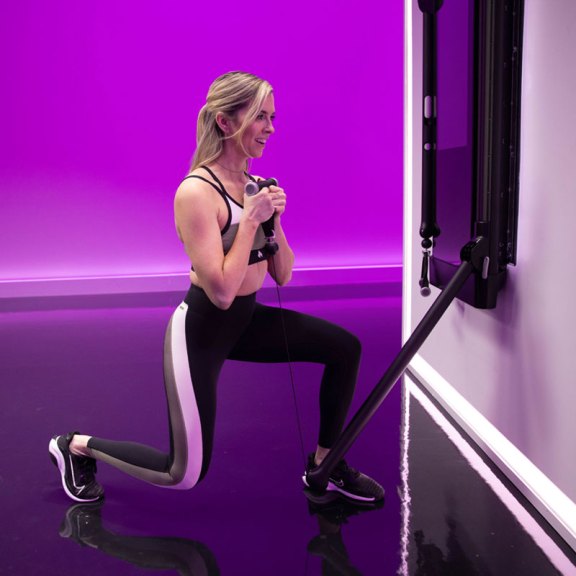
Why it Works: Wilking suggests adding a lunge to your lower-body push workout to build unilateral strength and reduce asymmetries between your two legs.
How to Do it: Hold the handle at the strap with thumbs wrapped around the top. Position it in front of your chest, and stand tall at the end of Tonal’s arm. Lower one leg behind you so that your knee just barely meets the mat, toes tucked on the floor, and try to create 90-degree angles with both knees. Push the floor away with the front leg to stand again, and repeat on the same side.
At-Home Push Workout With No Equipment
It’s possible to do a solid at-home push workout with just your body weight. Whether you’re a beginner still mastering foundational exercises or you’re traveling and don’t have access to your normal equipment, you can do these moves to work your pushing muscles wherever you are.
Pushup
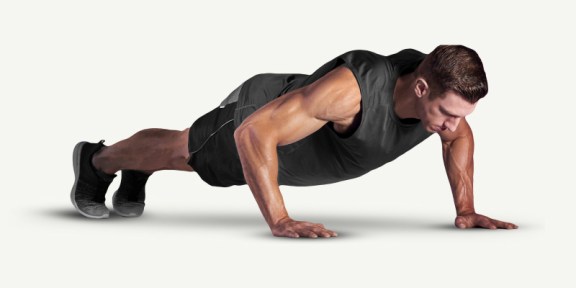
Why it Works: Pushups work the chest muscles in a similar movement pattern as a bench press, according to Wilking, so they’re a great option for working your pecs—plus your shoulders and triceps—with only your body weight. If a regular pushup is too challenging, try an incline pushup, resting your hands on a chair or low bench.
How to Do it: Bending the elbows about 45 degrees from the torso, drop your chest toward the floor aiming for your fingertips. Once at the bottom, push the floor away from you while pressing with your chest.
Foot-Elevated Pushup
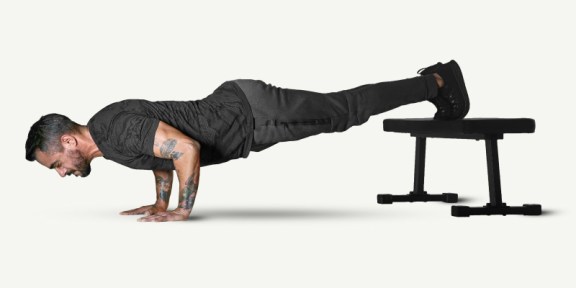
Why it Works: Just as changing the angle of a chest press alters the specific muscles being worked, you can do different pushup variations to isolate different parts of your chest. This variation is more difficult than a standard pushup and puts more weight on your upper pecs and the front of your shoulders.
How to Do it: Place your hands on the floor a few feet away from the bench, slightly wider than your shoulders. Position both feet on the bench with toes tucked. Bend at your elbows and keep your upper arm about 45 degrees from your torso as you drop down and aim your collar bones to the floor. Once at the bottom, push the floor away from you, pressing with your chest, and repeat.
Bodyweight Squat
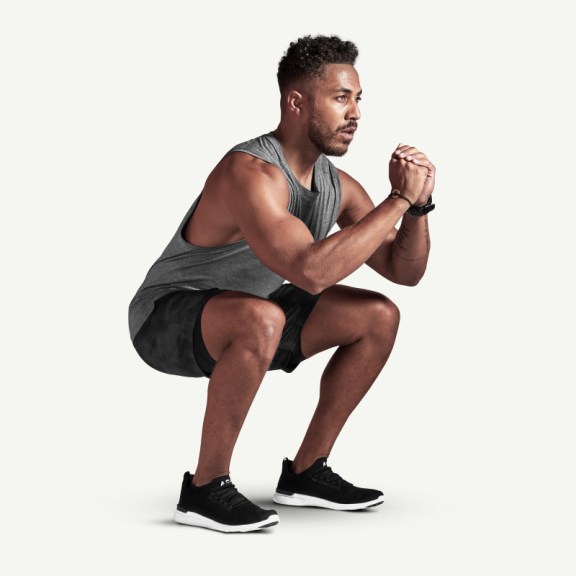
Why it Works: Just like the goblet squat, this squat variation will get your quads burning but without any added resistance.
How to Do it: Keeping your chest open, reach your hips back like you’re sitting into a chair. Press the floor away from you and squeeze your glutes to power the hips forward toward Tonal and stand tall.
Reverse Lunge
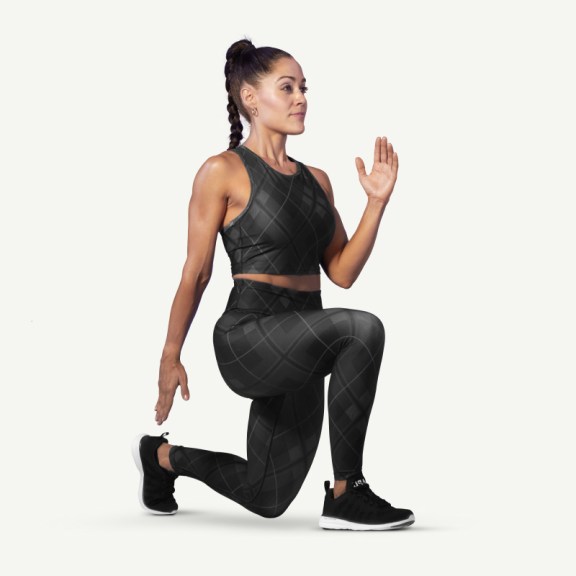
Why it Works: Add in a unilateral lower-body push move for balance. Working on your lunges will ultimately build up quad strength for better squatting.
How to Do it: Lower one leg behind you so that your knee just barely meets the mat, toes tucked on the floor and arms moving oppositely. Try to create 90-degree angles with both knees. Push the floor away with the front leg to come back to standing and repeat on the same side.
At-Home Push Workouts on Tonal
Try a workout that’s already designed by expert coaches. These on-Tonal sessions include many of the exercises Wilking recommends above to power up your pushing muscles.
Quick Fit: Push the Pecs – Coach Tim Landicho
With just two exercise variations, this short-but-effective workout hits your chest from multiple angles for well-rounded strength. In less than 15 minutes, you’ll be feeling the burn in your pecs and shoulders.
Quick Fit: Upper-Body Push and Burn – Coach Ackeem Emmons
This quick session focuses on single-sided movements to improve symmetry and balance in your chest and shoulders. You’ll finish the workout with a round of triceps kickbacks with Burnout mode activated to really feel the pump.
Classic Push/Pull/Legs: Push II
Train at your own pace in this Custom by Tonal workout that features a mix of essential push exercises plus a dynamic warmup and cooldown.
